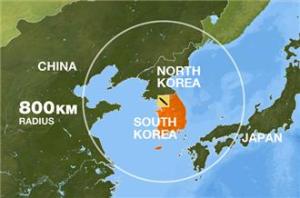By Greg Thielmann
 The 800 kilometer range arc for missiles from Seoul. Credit: Al Jazzera
The 800 kilometer range arc for missiles from Seoul. Credit: Al Jazzera
The United States and it close ally, the Republic of Korea (ROK), have just scored an "own goal" by agreeing to allow ROK development of longer-range ballistic missiles – a move that will set back international efforts to discourage the proliferation of ballistic missiles that can carry nuclear warheads.
Seoul announced an agreement on October 7 that the United States would support the ROK's development of 800 km range/500 kg payload missiles, which would allow Seoul to target all of the Democratic Peoples Republic of North Korea (DPRK) from any point in South Korea.
Both the United States and South Korea are members of the Missile Technology Control Regime (MTCR) -- a voluntary regime of 34 countries, which seeks to limit the spread of ballistic missiles and other unmanned delivery systems that could be used for chemical, biological, and nuclear attacks. When Washington successfully promoted South Korea's MTCR membership in 2001, Seoul had agreed to abide by the MTCR standard of 300 km range/500 kg payload.
The excuse for the unfortunate extension of South Korea's ballistic missile range capability is the continuing advances in the DPRK's nuclear and missile programs and its belligerent behavior toward the South. The reality, however, is that South Korea's conventional military edge over its northern neighbor continues to grow and U.S. political backing for the ROK's territorial integrity is unwavering.
A fleet of longer-range ballistic missiles will provide additional military options for South Korea in acting alone against the North, but it will not erase the potential DPRK nuclear threat. Nor will it significantly enhance the pre-emptive or retaliatory options already available to the combined forces of the United States and South Korea.
Although few would attribute nuclear weapons intentions to the current government in Seoul, as Jeffrey Lewis reminds us in his Foreign Policy analysis yesterday, South Korea had a covert nuclear weapons program through the 1980s. Agitation within some South Korean political circles for development of ICBMs adds fuel to the fire for those concerned about the ultimate destination of Seoul's military build-up.
So Much for the Neighbors
Even without Seoul advancing nuclear-tipped ballistic missiles as an end-goal, the near tripling of South Korea's indigenous ballistic missile range/payload capability will spawn concerns in the region about its latent nuclear weapons delivery vehicle capabilities. An 800 km range arc from the borders of South Korea includes the northeastern coast of China down to Shanghai and the principal ports of Russia's Far East (Vladivostok and Nakhodka), as well as nearly half of Japan.
North Korea
Finally, to endorse the political-military efficacy of extending ballistic missile range in this way is exactly the wrong message for North Korea in the context of the six-power negotiations. Instead of convincing Pyongyang that it has little to gain in developing and deploying ballistic missiles against South Korea and its allies, it would appear to attest to the potent deterrent value of missiles – even for a country like South Korea with superior conventional forces – and to signal a lack of trust in the reliability of Seoul's superpower protector.
So far, Pyongyang has responded by claiming its readiness to strike the United States with nuclear weapons in response to a nuclear attack – a not very convincing threat in light of its four failures over fourteen years to successfully launch a prototype ICBM.
But the U.S.-ROK decision on longer-range ballistic missiles could easily provide North Korea with a cynical excuse to undertake further provocative actions over the coming months – such as a third nuclear weapon test or additional tests of future longer-range ballistic missiles.
INF
A supreme irony in this latest development is that the United States has given a green light to an ally to develop missiles of a category that it has itself foresworn. The landmark 1987 INF Treaty, which will enjoy its 25th anniversary this December, banned all U.S. and Soviet ballistic missiles with ranges between 500 km and 5500 km.
The INF Treaty even led to the elimination of other national systems outside the formal accord -- like West Germany's Pershing IA, with a range of 740 km. The latest agreement has poured cold water on the hopes of many that the bilateral INF Treaty could be used as a starting point in a multilateral process and others that the widespread scope of adherence to MTCR thresholds could be used as a foundation for further progress.
Whatever benefits the agreement might provide for the bilateral U.S.-ROK relationship, it will be more than offset by the damage to U.S. relations with other important players in the region and to the effectiveness of the MTCR world-wide. Rarely has a "security" agreement left so many feeling less secure.
